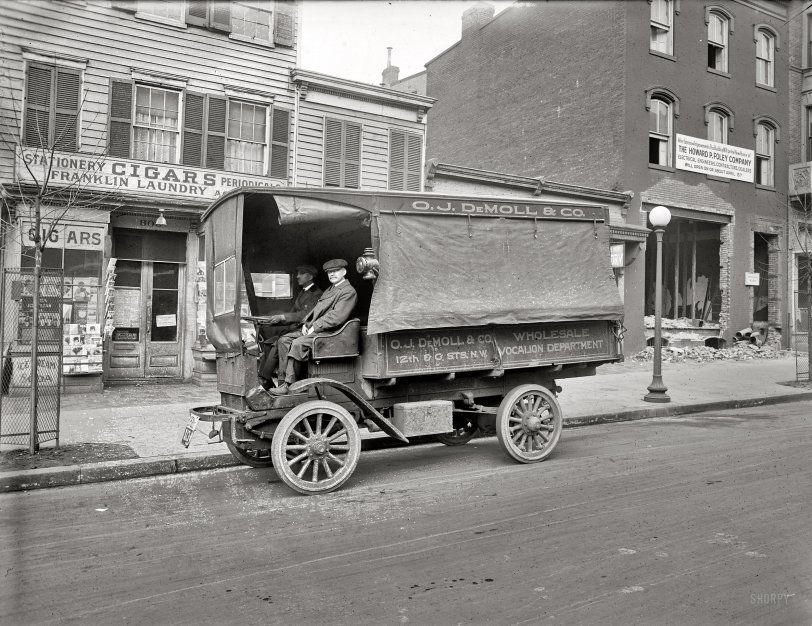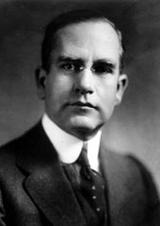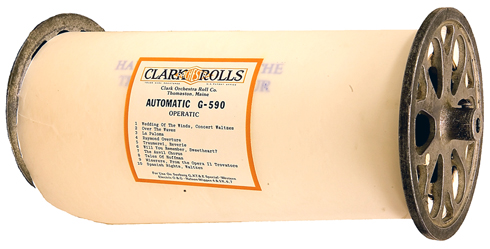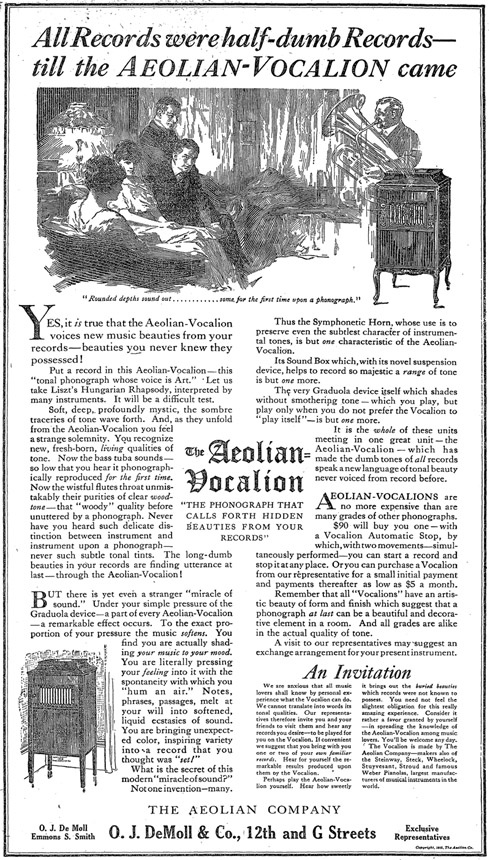


Framed or unframed, desk size to sofa size, printed by us in Arizona and Alabama since 2007. Explore now.
Shorpy is funded by you. Patreon contributors get an ad-free experience.
Learn more.

- Baldwin 62303
- Baldwin VO-1000
- Cold
- No expense spared
- Tough Guys
- Lost in Toyland
- And without gloves
- If I were a blindfolded time traveler
- Smoke Consumer Also Cooks
- Oh that stove!
- Possibly still there?
- What?!?
- $100 Reward
- Freeze Frame
- Texas Flyer wanted
- Just a Year Too Soon
- WWII -- Replacing men with women at the railroad crossing.
- Yes, Icing
- You kids drive me nuts!
- NOT An Easy Job
- I wonder
- Just add window boxes
- Icing Platform?
- Indiana Harbor Belt abides
- Freezing haze
- Corrections (for those who care)
- C&NW at Nelson
- Fallen Flags
- A dangerous job made worse
- Water Stop
Print Emporium
Saucy Stories: 1920

Washington, D.C., circa 1920. "O.J. DeMoll Co., Autocar truck." The cigar store has an interesting selection of magazines, including one called Saucy Stories. Mold-spotted National Photo Company glass negative. View full size.
Shadowland magazine
What caught my eye in the magazine rack close-up is the Shadowland Magazine. I've googled this but have only come across worn copies being sold on eBay or old magazine sites that have a lot of missing web pages. I was wondering if someone could perhaps point me in the right direction for this particular magazine. I'm a big fan of old photographs, publications, music, architecture, and culture (and subculture).
[Try Alibris.com - Dave]
System magazine
System Magazine was published and edited out of 151 Wabash Ave, Chicago, by Arch W. Shaw (b. Michigan 1876, d. 1962), one of the preeminent business book publishers from 1910 to 1930. Helped Harvard (where he taught now and again) get its Business Review magazine going in 1922. Also a partner in the Kellogg Company.
The magazine became Business Week in 1929.

Grandma's DeMoll
My grandmother had an O.J. DeMoll upright piano in her home in the Anacostia section of Washington. After she died we inherited it. Unfortunately, the movers bounced it around, shifting the harp and soundboard. The piano wasn't worth much, so it was eventually hauled away. We still have the stool that went with it -- it is now a rather nice plant stand.
I wonder if that truck delivered our old piano to my grandmother's house.
All-Story Weekly
The All-Story Weekly in the middle on the right is the March 6, 1920, issue.

It's a jungle out there
Edgar Rice Burroughs, creator of Tarzan, wrote for System Magazine. He was turned off by the fact that writers like him, with no business experience, were supposed to provide advice to business managers in the journal. He began sending stories out to be published, first science fiction stories, then the Tarzan stories, in order to be able to leave the magazine and make it as a writer on his own.
System Magazine
"System" magazine--anyone know what topics it covered?
["The Magazine of Business." - Dave]

Autocar Prices
This Autocar motor truck sold for $2325 ($2150 for chassis only) - not much more than the highest priced Vocalion. Photo and all the specs are in the 1912 Official Handbook of Automobiles - page forward and back for other Autocar models.
Vocalion
They needed a huge truck to deliver piano rolls?
[Vocalion was also a brand of Aeolian phonograph (and later, record label). DeMoll was a big dealer in player pianos and Aeolian phonographs (its 12th Street showroom was named Aeolian Hall). Click below to enlarge. - Dave]
Autocar truck
Some interesting items to note. This is one of the first cab-over-engine trucks. It also has a front bumper, hand crank, and leather crank holder. Note the tarp that rolls down for the windshield, with the two celluloid panels for viewing. Also the side curtains, rolled up on the camera side. The truck has two side lamps, no headlamps, and solid rubber tires. Brakes at the rear only. Year of the truck is about 1912.
Victor, Columbia, Edison, Vocalion
The Vocalion brand name started out in the pre-World War One player piano era, and lasted all the way into the late 1930's.
As it went along, the company made the transition from piano rolls to distinctive red shellac records (with a quite beautiful Gothic-style, multicolored, lithographed label), to what were called "race" records (aimed at the emerging African-American market).
By the late 30's, Vocalion was recording everything from novelty groups like the Hoosier Hot Shots to the immortal, haunting Delta blues of Robert Johnson. There seems to have been one, consistent policy in
force at the label: "Maybe it's obscure, but if it's good, we'll issue it."
Vocalion Records finally disappeared in the buyout of its parent company, the American Record Corporation, by CBS in 1939. However, many of its best recordings were reissued on the Columbia label, as a result, and continued to sell.
Why the Bulletin?
The newspaper covering one of the doors appears to be the Bulletin, an afternoon daily published in Philadelphia (and, in this instance, reporting on the progress toward ratification of the Ninteenth Amendment). With the headquarters of both the evening Star and the morning Post a few blocks away, the choice of the Bulletin seems odd.
[I'd imagine there were dozens of newspapers called the Bulletin. This particular "Bulletin" seems to be a page of Washington theater listings. - Dave]
Popular Mechanics
That issue of Popular Mechanics at the bottom of the narrow rack is from March 1920. The cover features an elephant carrying a motorcycle.

Saucy, Not Spicy
Most of the stories in Saucy Stories were much like those in Captain Billy Fawcett's Whiz Bang. Most of it was on the order of "He drinks to calm himself. Last night he got so calm he couldn't move."
In all probability, that Billboard had ads for various acts and actors that could afford advertising, the "pipes for pitchmen," ads for novelties, "slum," carnival routes, and other items relevant to amusement business generally.
It might interest some to know that at that time, a concessionaire generally paid 5 percent of their gross to the venue. Today that's as much as 70 percent. No wonder hot dogs are so expensive at the state fair.
Old Radio Man
Prices
We often see the prices and think nostalgically of the old days.
Well, look at some of the prices listed here. Songs rolls for $1 - which in today's money would be $12. Even if you buy music now (and seemingly fewer and fewer do), we pay a dollar a song on iTunes.
But, how about a new Aeolian-Vocalion for $2000! That would be around $25,000 in present day dollars.

Billboard
Though Billboard is primarily known as a music magazine, it predates the rise of the record industry. It began as a trade publication for advance men (theater, music, even circuses) who went town to town posting bills to publicize upcoming entertainment events.
Dedicated coverage of music and music sales came much later, through the connection that a touring musician had advance men, as well as a vaudeville or comedy, or theater troupe. But early Billboard was about touring road shows and the people who worked behind the scenes to publicize those.
Saucy Stories
According to the Magazine Data website (philsp.com) Saucy Stories was founded by H.L. Mencken and George Jean Nathan in 1916, then sold by them within in a year. I am surprised that this was displayed in the window as I have always thought of this type of pulp as being an under the counter item. As a pulp magazine fan I would love to see a close up of the magazines.
[Click the first link in the caption for a closeup. - Dave]
O.J. DeMoll & Co.
The photo is at 12th and H streets northwest. The July 24, 1919 Post reports that the Howard P. Foley Company is remodeling the building at 806 12th street for use as a store and office building.
The Billboard
That Billboard magazine in the window would come as a shock to someone reading it today as it *gasp* didn't include any music charts! The first hit parade wasn't published by the magazine until 1936. Instead readers were likely to find reviews of motion pictures and live events, as well as listings of upcoming shows.
[Subtitle on the cover is "A Weekly Theatrical Digest." - Dave]


























On Shorpy:
Today’s Top 5